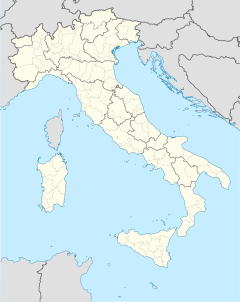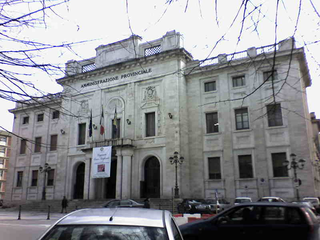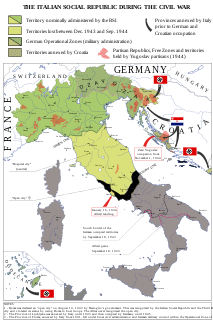This article includes a list of references, related reading or external links, but its sources remain unclear because it lacks inline citations .(October 2012) (Learn how and when to remove this template message) |
| Servigliano prison camp | |
|---|---|
| prison camp | |
| Coordinates | 43°13′N13°30′E / 43.217°N 13.500°E Coordinates: 43°13′N13°30′E / 43.217°N 13.500°E |
| Location | Servigliano |
| Operated by | Italy |
| Operational | October 1940 |
| Inmates | Prisoners of war |
| Liberated by | September 1943 |
Servigliano prison camp began as a POW camp for Austrian soldiers of World War I. Following Italy's entry to World War II, the fascist government used it as a concentration camp for civilian and military prisoners between October 1940 to September 1943. The Italian Social Republic later converted it into a deportation camp for Jews between October 1943 and June 1944.

World War I, also known as the First World War or the Great War, was a global war originating in Europe that lasted from 28 July 1914 to 11 November 1918. Contemporaneously described as "the war to end all wars", it led to the mobilisation of more than 70 million military personnel, including 60 million Europeans, making it one of the largest wars in history. It is also one of the deadliest conflicts in history, with an estimated nine million combatants and seven million civilian deaths as a direct result of the war, while resulting genocides and the 1918 influenza pandemic caused another 50 to 100 million deaths worldwide.
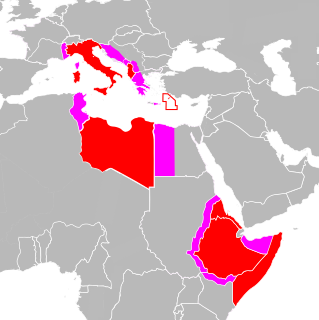
The participation of Italy in the Second World War was characterized by a complex framework of ideology, politics, and diplomacy, while its military actions were often heavily influenced by external factors. Italy joined the war as one of the Axis Powers in 1940, as the French surrendered, with a plan to concentrate Italian forces on a major offensive against the British Empire in Africa and the Middle East, while hoping for the collapse of the UK in the European theatre. The Italians bombed Mandatory Palestine, invaded Egypt and occupied British Somaliland with initial success. However, German and Japanese actions in 1941 led to the entry of the US and the USSR in the War, thus ruining the Italian plan and postponing indefinitely the objective of forcing Britain to agree to a negotiated peace settlement.

World War II, also known as the Second World War, was a global war that lasted from 1939 to 1945. The vast majority of the world's countries—including all the great powers—eventually formed two opposing military alliances: the Allies and the Axis. A state of total war emerged, directly involving more than 100 million people from over 30 countries. The major participants threw their entire economic, industrial, and scientific capabilities behind the war effort, blurring the distinction between civilian and military resources. World War II was the deadliest conflict in human history, marked by 50 to 85 million fatalities, most of whom were civilians in the Soviet Union and China. It included massacres, the genocide of the Holocaust, strategic bombing, premeditated death from starvation and disease, and the only use of nuclear weapons in war.
Contents
After World War II the camp was converted into a refugee camp for people coming from Istria, Libya and Ethiopia. It ceased to operate in 1955 and in 1970 it was finally dismantled.
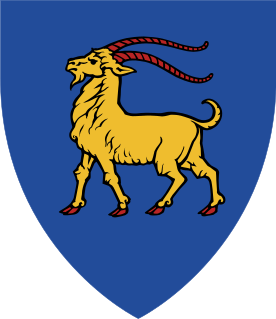
Istria, formerly Histria (Latin), Ίστρια, is the largest peninsula in the Adriatic Sea. The peninsula is located at the head of the Adriatic between the Gulf of Trieste and the Kvarner Gulf. It is shared by three countries: Croatia, Slovenia, and Italy. Croatia encapsulates most of the Istrian peninsula with its Istria County.

Libya, officially the State of Libya, is a country in the Maghreb region in North Africa, bordered by the Mediterranean Sea to the north, Egypt to the east, Sudan to the southeast, Chad to the south, Niger to the southwest, Algeria to the west, and Tunisia to the northwest. The sovereign state is made of three historical regions: Tripolitania, Fezzan and Cyrenaica. With an area of almost 1.8 million square kilometres (700,000 sq mi), Libya is the fourth largest country in Africa, and is the 16th largest country in the world. Libya has the 10th-largest proven oil reserves of any country in the world. The largest city and capital, Tripoli, is located in western Libya and contains over one million of Libya's six million people. The second-largest city is Benghazi, which is located in eastern Libya.

Ethiopia, Oromo: Itiyoophiyaa, Somali: Itoobiya, Hebrew: אתיופיה -officially the Federal Democratic Republic of Ethiopia, is a country in the northeastern part of Africa, popularly known as the Horn of Africa. It shares borders with Eritrea to the north, Djibouti to the northeast, and Somalia to the east, Sudan and South Sudan to the west, and Kenya to the south. With over 102 million inhabitants, Ethiopia is the most populous landlocked country in the world and the second-most populous nation on the African continent that covers a total area of 1,100,000 square kilometres (420,000 sq mi). Its capital and largest city is Addis Ababa, which lies a few miles west of the East African Rift that splits the country into the Nubian Plate and the Somali Plate.
